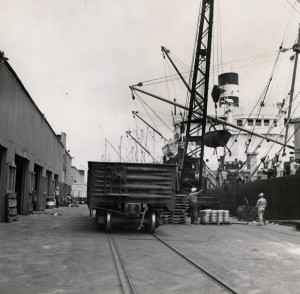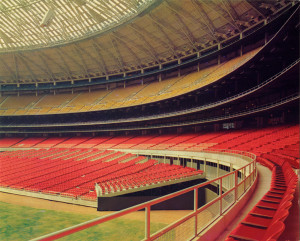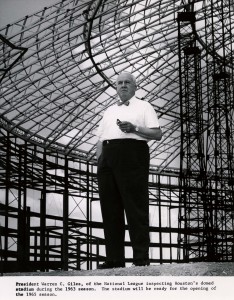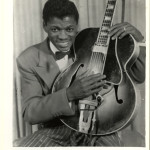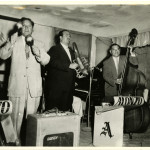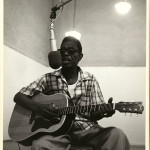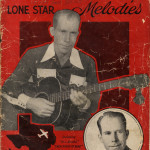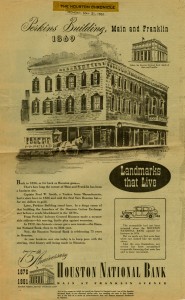
This week not only marks the arrival of the fall semester and the return of students to the University of Houston campus but, as mentioned earlier in the week, it also marks the arrival of our newest fellow, Stacey Lavender.
As the Houston Arts and History Archives Fellow, Stacey will assist with the processing of archival collections and other tasks associated with the Performing Arts, Houston & Texas History, and Houston Hip Hop collecting areas.
In regards to what drew her to this fellowship, Stacey writes:
I was definitely excited that the position was specifically directed at recent graduates and that I would have the opportunity to work with several different types of collections. I also have just always had the eventual goal of working in a university library and I hadn’t had the opportunity to do that during graduate school. So I thought this would be a really great way to take the skills and knowledge I had from my previous work and educational experiences and learn to use them in a university library setting.
A native of the greater Houston area, Stacey joins us from Michigan where she earned her MS in Information from the University of Michigan. While in Ann Arbor she also worked at the U.S. Geological Survey, Great Lakes Science Center, as a Science Records Intern, and as a Student Archivist at the Gerald R. Ford Library in Ann Arbor. Earning her BA in History at Rice, she also has experience as a Records Specialist at the James A. Baker III Institute for Public Policy.
We are very excited to welcome Stacey and have her lending her expertise to the UH Special Collections.
Roll on, thou deep and dark blue Ocean – roll!
Ten thousand fleets sweep over thee in vain;
Man marks the earth with ruin – his control
Stops with the shore; – upon the watery plain
–Lord Byron, from Childe Harold’s Pilgrimage, canto II
In our youth, the world we inhabit is too large, too grand in our vision to fathom. As we grow older, we are amazed to find it shrinking and shedding some of its grandeur. We begin to find it more manageable, we devour it piecemeal, and dismiss the notion that anything was ever too large for us.
Occasionally, however, we are reminded.
The spectacles of nature remind us. The mysteries unlocked about ourselves remind us. Or, regardless of age, surveying a vast expanse of ocean and marveling at the unfathomable that envelops our little, blue rock, reminds us.
One of the joys of working with primary sources and artifacts of our past is that these seemingly small things still have the capacity to take us back there, remind us of how large and unwieldy the world is and how small but, at the same time, how significant and vital we each are. Recently the University of Houston Libraries received a communication from a patron conducting research in the Ship Channel Collection of our Digital Library. Upon discovering a photograph of an old friend, the SS Sue Lykes, she writes:
We can’t believe our luck at finding a photograph of the SS Sue Lykes in your collection. In 1954 the same vessel pictured unloading barbed wire on May 18th 1950 brought our family – Mother and three young girls – from London to Galveston (Dad had come over six months before on the Thompson Lykes and docked in the port of Houston. He had only just managed to earn the fare for us to come and wired it just in time to sail. We remember two other children on the ship, the Russian captain and several other passengers and crew. Lykes had very little, if any, cargo on board. The open expanded metal stairs were terrifying to climb and grandmother had to come behind us encouraging us up to the deck. We left London down the Thames, under the Tower Bridge and out to the sea – riding very high in a thick fog with the fog horn blasting – very exciting and frightening. It took us a month (approx. 15th November? to 16th December, 1954) to reach Galveston as we encountered an exceedingly violent North Atlantic storm, if not a hurricane. Bunk beds fell from the walls and my 6 year old mind wondered why the ship’s bow was going underwater. We upended a card table and slid across the cabin with the roll of the ship. I think there was some damage to the ship as repairs were made during the storm to something the first mate (who we liked because he gave us chocolate) had to scale. Veering southward towards the Azores to avoid any more difficulty, the ship crossed the Atlantic much further south than expected. Mom said she saw fires on the beach. We arrived in Galveston and saw that our Father was beside himself with worry. The ship had been out of contact. We know she has been scuppered and two or three have had her name by now, but we are so fond of that ship that brought us safely here.
With her recollection, an unassuming snapshot from the past is irreversibly altered. It becomes a reminder of the peril, wonder, and joy of youth — as well as the richness and warmth that comes through age and experience. As tiny as we can be, at times, we are still significant enough to bring about that sort of meaning and understanding to one another.
We thank our patron for sharing her story and take this opportunity to encourage you to do some exploration of your own — online or off. You never know what old friends you might find.
Today the National Trust for Historic Preservation released its 26th annual list of America’s 11 Most Endangered Places, and guess who made the list.
For Astrodome preservationists, the announcement comes not a moment too soon.
Just a few months ago NFL Commissioner Roger Goodell started rattling the wrecking balls, suggesting it would enhance Houston’s chances of hosting the 2017 Super Bowl should the Astrodome be demolished noting, “Whether it’s more parking, whether we can have more events there on that space — it’s not just the stadium itself, it’s the area surrounding it that’s valuable. And, I think that could be a very positive change in their Super Bowl bid.” (Footnote: Houston was later awarded the bid with no definite word on the future of the Dome.)
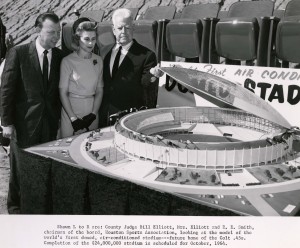 So, naturally, the threat of the Dome’s demise has many waxing nostalgic, including yours truly, and finds me digging through the George Kirksey Papers. Kirksey, along with Roy Hofheinz and others, was instrumental in bringing Major League Baseball to Houston. The scope of his papers, held here at the University of Houston Special Collections, extends beyond baseball, but they do contain some real photographic gems from the Dome’s design, groundbreaking, and through its golden era (some included here).
So, naturally, the threat of the Dome’s demise has many waxing nostalgic, including yours truly, and finds me digging through the George Kirksey Papers. Kirksey, along with Roy Hofheinz and others, was instrumental in bringing Major League Baseball to Houston. The scope of his papers, held here at the University of Houston Special Collections, extends beyond baseball, but they do contain some real photographic gems from the Dome’s design, groundbreaking, and through its golden era (some included here).
Goodell was right about the Astrodome and the land it is on being valuable. It is just that not everything can be calculated via a return-on-investment spreadsheet, and the true value of the Astrodome, standing in some form or another, is beyond mere value as we understand it these days in Houston.
Reading the tea leaves of the Dome’s future is an exercise in futility and frustration. However, it is encouraging to see Mayor Parker express interest in preservation ideas akin to the master’s project of UH’s own Ryan Slattery, but the future of the Dome is still in doubt.
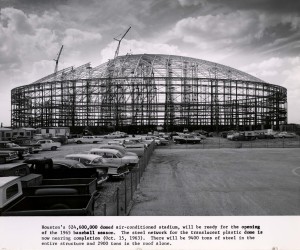 Whatever becomes of it, there is not much that can be said here that has not already been captured by a number of impassioned pleas, linking Houston’s sporting history to that of the Astrodome’s timeline. However, for those who are not sports fans or who did not make memories in this grand experiment of a stadium, let us set aside the history of the Astros, the Oilers, the Houston Livestock Show and Rodeo, the Game of the Century, the Battle of the Sexes, et al. The Astrodome speaks to something larger.
Whatever becomes of it, there is not much that can be said here that has not already been captured by a number of impassioned pleas, linking Houston’s sporting history to that of the Astrodome’s timeline. However, for those who are not sports fans or who did not make memories in this grand experiment of a stadium, let us set aside the history of the Astros, the Oilers, the Houston Livestock Show and Rodeo, the Game of the Century, the Battle of the Sexes, et al. The Astrodome speaks to something larger.
That this audacious figment of our collective imagination (No mosquitoes? Air-conditioned baseball in Houston?!) could be brought into being, transcends the idea or concept of a niche sporting audience and speaks to us not solely in terms of sport. It speaks, perhaps, more in terms of our ingenuity, our desire to always overcome and produce that which seems futile or silly and, admittedly, to do so in ways that may see the execution of it all fall short of our lofty, futuristic visions.
So, there it was built and there it stands, as a monument to all that is comical and wonderful and, yes, endearing about us. It remains a symbol of our moonshot in an era where the Moon seemed suddenly within reach.
Driving by the Astrodome at night, even dwarfed as it is by the sterile Reliant Stadium, it seems to grumble, “We are the masters of our domain. We will control the environment on a massive scale, and we will restore novelty to the novel, creating a spectacle of sport again. We will always figure out how to manifest our yearning in ways that are bigger and infinitely more ingenious, for better or for worse.”
A little hubris, there? Perhaps. But, then, all the more reason to retain it as a reminder. Either as an albatross or our Eiffel, the Dome should stand.
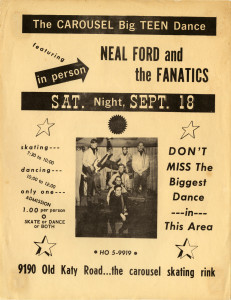
Hey all you cool cats! It’s the Carousel Big Teen Dance Saturday night down on Old Katy Road with Neal Ford and the Fanatics!
Just over a month ago, the University of Houston Special Collections kicked off their series of “Brown Bag” seminars, highlighting some of the unique work of processing and preserving research materials in our various collecting areas, as well as efforts to make these materials more accessible to interested researchers.
The first in this series, led by our Houston and Texas Archives Fellow Alison Clemens, introduced some basics of navigating the winding path of research in Special Collections and also highlighted our Texas Music Collection. Thanks to the wonders of modern technology, as well as the YouTube channel maintained by the University of Houston Libraries, those of us unable to attend the seminar can still enjoy a taste of it from the comfort of our favorite glowing screen. In the video below, both novice and experienced researchers will appreciate Ms. Clemens’s introduction to Archon, an online retrieval tool for navigating our various collections, as well as a look at how some of the materials showcased lend themselves to particular research projects or hold unique connections warranting further study.
Please enjoy the video recap along with the accompanying images below and, while you’re at it, take some time to explore the Texas Music Collection finding aid. However, if you really want to experience the Texas Music Collection, or any of our other collections under the Houston and Texas History umbrella, no amount of technology can quite replicate a visit to our Reading Room.
(All images pulled from the Texas Music Collection)
- Gatemouth Brown
- Alonzo y Sus Rancheros, c. 1950s
- Lightnin’ Hopkins, 1968
- Floy Tillman’s Lone Star Melodies
The finding aid for the Houston National Bank Records (1889-1964) has recently been published as part of our Houston and Texas History collection area. The records for the Houston National Bank, founded in 1876, contain administrative files as well as scrapbooks from individuals associated with the bank.
The Houston National Bank was founded in 1876, moved into the bustling and growing downtown area in 1928, and remained a financial cornerstone in the city until it merged with the Tennessee Bank and Trust Company in 1964. Its former home, a beautiful neoclassical construction of limestone on a black granite base, sat vacant as the 20th century came to a close. University of Houston alumnus Hakeem Olajuwan purchased the property and it now breathes new life as the Islamic Da’wah Center.
The Houston National Bank Records consist primarily of correspondence, photographs, news clippings, and promotional material related to the 75th and 85th anniversary celebrations in 1951 and 1961 respectively. Personal papers and scrapbooks belonging to the likes of former bank president Melvin Rouff round out the collection.
Of course, we are excited about this new finding aid. Please give it look and, should you find something of import to your research, please visit us at your earliest convenience.
